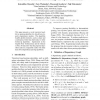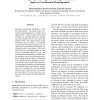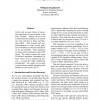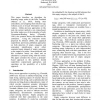111
Voted
ACL
2012
13 years 3 months ago
2012
We examine some of the frequently disregarded subtleties of tokenization in Penn Treebank style, and present a new rule-based preprocessing toolkit that not only reproduces the Tr...
97
Voted
ACL
2012
13 years 3 months ago
2012
This paper presents a novel top-down headdriven parsing algorithm for data-driven projective dependency analysis. This algorithm handles global structures, such as clause and coor...
101
Voted
ACL
2011
14 years 4 months ago
2011
Resolving coordination ambiguity is a classic hard problem. This paper looks at coordination disambiguation in complex noun phrases (NPs). Parsers trained on the Penn Treebank are...
109
Voted
EMNLP
2009
14 years 10 months ago
2009
This paper presents a simple and effective approach to improve dependency parsing by using subtrees from auto-parsed data. First, we use a baseline parser to parse large-scale una...
EMNLP
2010
14 years 10 months ago
2010
Syntactic consistency is the preference to reuse a syntactic construction shortly after its appearance in a discourse. We present an analysis of the WSJ portion of the Penn Treeba...
97
Voted
ACL
2010
14 years 10 months ago
2010
We present algorithms for higher-order dependency parsing that are "third-order" in the sense that they can evaluate substructures containing three dependencies, and &qu...
105
Voted
EMNLP
2006
15 years 2 months ago
2006
In this work we learn clusters of contextual annotations for non-terminals in the Penn Treebank. Perhaps the best way to think about this problem is to contrast our work with that...
109
Voted
ACL
2006
15 years 2 months ago
2006
This paper describes a parser which generates parse trees with empty elements in which traces and fillers are co-indexed. The parser is an unlexicalized PCFG parser which is guara...
92
Voted
ACL
2004
15 years 2 months ago
2004
This paper describes an algorithm for detecting empty nodes in the Penn Treebank (Marcus et al., 1993), finding their antecedents, and assigning them function tags, without access...
83
Voted
NAACL
2007
15 years 2 months ago
2007
We present a method for automatic determiner selection, based on an existing language model. We train on the Penn Treebank and also use additional data from the North American New...




